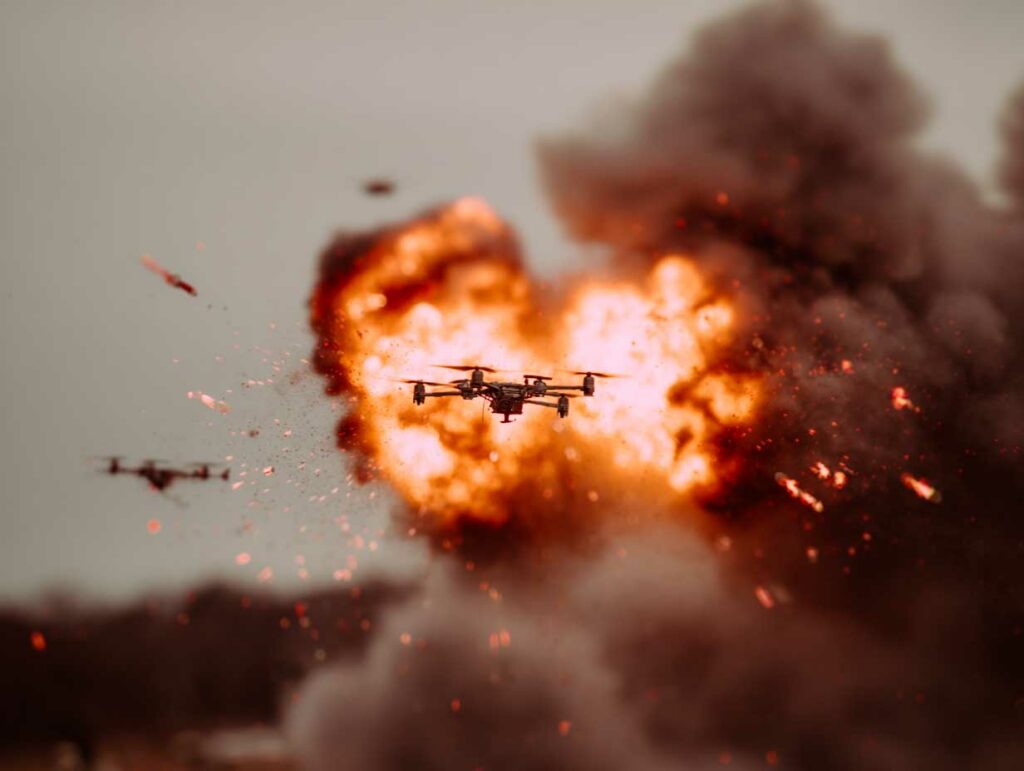
Harmattan AI’s GOBI drone intercepts threats in flight in less than a minute. Technical analysis of a lightweight, autonomous, and operational system.
The GOBI drone, developed by French startup Harmattan AI, is a tactical response to evolving aerial threats, particularly loitering munitions such as the Shahed-136. Weighing less than 2 kilograms, this interception system is designed to neutralize a target in less than 60 seconds after launch. With an autonomous architecture that can be integrated into command and control networks, it detects, tracks, and engages enemy drones in complex environments. The GOBI is the result of an approach focused on embedded artificial intelligence, capable of reacting quickly without direct human supervision. This innovation marks a break with traditional close air defense doctrine. In July 2025, Harmattan AI was awarded a multi-million euro contract by a NATO member state, less than 15 months after its creation, with deliveries scheduled to begin in October.
A technical response to asymmetric air threats
The intensification of modern conflicts, such as in Ukraine, has demonstrated the effectiveness of low-cost kamikaze drones, often used in swarms. In response to this development, conventional defenses (anti-aircraft guns, surface-to-air missiles) are proving expensive, slow, and oversized for low-value targets. The GOBI takes the opposite approach: speed, compactness, and targeted action.
Low weight for maximum responsiveness
The GOBI drone weighs less than 2 kilograms. This reduces its aerodynamic drag and facilitates its deployment in tactical environments without the need for heavy infrastructure. Its small size allows it to be transported at platoon level and launched from a compact tube or rail mounted on a light vehicle.
Thanks to its high-efficiency electric motors and optimized onboard electronics, the GOBI can reach a target in less than a minute after detection, reducing the firing window of the enemy threat. This performance contrasts sharply with the reaction times of conventional anti-aircraft batteries, which require several human steps before engagement.
An onboard, autonomous detection system
The GOBI is not just a remote-controlled projectile. It carries a suite of miniaturized sensors—an infrared camera, a visible optical sensor, and an inertial accelerometer—and an artificial intelligence-based decision-making system trained to recognize the silhouettes and trajectories of commonly used drones.
All of these devices enable the drone to detect, identify, track, and engage a target in real time, without continuous human control. This autonomy drastically reduces the latency between identification and neutralization, which is essential when dealing with loitering munitions traveling at 150 to 200 km/h at low altitude.

A modular architecture designed for distributed warfare
The GOBI interceptor is designed not only for its flight performance, but also for its ability to be integrated into larger systems. Its software and hardware structure meets the current needs of Western armed forces, which are faced with fragmented, complex and networked engagements.
Interoperability with existing C2 platforms
The GOBI can be integrated into a command and control (C2) system via standard encrypted communication protocols. This allows it to receive detection data from radars, optical sensors, or electronic listening stations. In return, it can share target locations, its own trajectory, and operational status in real time.
This interoperability ensures dynamic synchronization with other defense systems (jammers, scramblers, short-range missiles) and prevents friendly fire in areas densely populated with friendly and enemy drones. It also allows for optimized distribution of neutralization loads: a GOBI is only launched if another weapon is less effective or unavailable.
An evolving software platform
Harmattan AI has designed its system with rapid software updates in mind, independently of the hardware. The core processing is based on an embedded neural network, whose learning layers can be retrained with new data sets (enemy behavior, thermal signatures, modified drone trajectories).
This architecture allows GOBI to remain operationally relevant against adaptive adversaries. It also allows new payloads (e.g., a microwave sensor or an electronic warfare module) to be easily integrated depending on the theater of engagement.
An industrial breakthrough for an emerging French player
The speed with which the GOBI program was implemented and contracted illustrates a rare industrial dynamic. Founded in April 2024, Harmattan AI went from concept to signing a contract with a NATO member country in less than 15 months, which is a record in the defense industry.
A landmark contract for a new player
The multi-million euro contract signed in July 2025 provides for initial deliveries as early as October. This rapid logistics turnaround is made possible by a production model adapted to warfare: flexible production lines, dual-use components, and standardization of critical parts.
The first series of GOBI units will be destined for operational units for the protection of logistics convoys, securing airborne zones and perimeter defense against drones (bases, power plants, command centers). An initial series of 500 units is planned for the ramp-up phase.
A disruptive industrial strategy
Harmattan AI is not based on a traditional sequential military engineering model. The company operates according to short iteration cycles, with a strong vertical integration between software development, additive manufacturing, and real-world testing. This approach, modeled on the methods of civilian technology start-ups, reduces the time between prototype and series production.
It also enables a faster response to urgent customer requests, particularly in conflict situations where tactical needs can change from one week to the next. This operating mode is compatible with decentralized production, which limits exposure to logistical disruptions in the event of a supply crisis.
A credible response to the challenges of modern conflict
The GOBI drone is not just a niche technology. It illustrates a transformation in the close air defense paradigm, combining speed, intelligence, compactness, and network integration. These characteristics make it suitable for a wide range of missions.
A doctrine of use under development
The GOBI can be used in close coverage for mobile units, in support of convoys or engaged sections. It can also form a dynamic anti-drone barrier around sensitive installations. In urban environments, it is capable of detecting drones emerging from buildings or flying at low altitudes.
It addresses the growing challenge of intercepting cheap, mass-produced drones used in large numbers. In this context, every second counts. The GOBI drastically reduces interception time while avoiding the depletion of strategic defense resources (heavy surface-to-air missiles, multi-barrel cannons, high-definition radars).
A logic of mass production and contained costs
The estimated unit cost of the GOBI is around $5,000 to $7,000, depending on the sensor/payload configuration. This price point makes it possible to envisage mass deployment, at a rate of one drone per identified threat. Unlike complex systems costing six figures per unit, the GOBI is economically viable in a war of attrition, targeting enemy platforms as soon as they approach.
Its compact size, logistical simplicity, and modularity make it an operational tool suitable for high-intensity conflicts, where heavy systems become unsuitable, vulnerable, or unavailable.
War Wings Daily is an independant magazine.